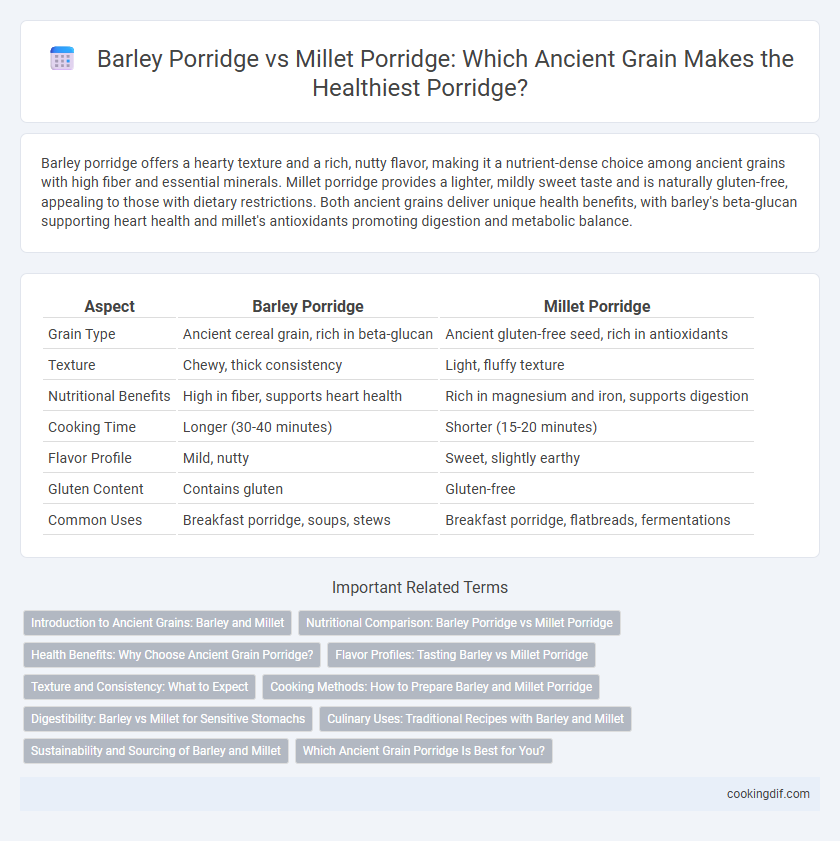Barley porridge offers a hearty texture and a rich, nutty flavor, making it a nutrient-dense choice among ancient grains with high fiber and essential minerals. Millet porridge provides a lighter, mildly sweet taste and is naturally gluten-free, appealing to those with dietary restrictions. Both ancient grains deliver unique health benefits, with barley's beta-glucan supporting heart health and millet's antioxidants promoting digestion and metabolic balance.
Table of Comparison
| Aspect | Barley Porridge | Millet Porridge |
|---|---|---|
| Grain Type | Ancient cereal grain, rich in beta-glucan | Ancient gluten-free seed, rich in antioxidants |
| Texture | Chewy, thick consistency | Light, fluffy texture |
| Nutritional Benefits | High in fiber, supports heart health | Rich in magnesium and iron, supports digestion |
| Cooking Time | Longer (30-40 minutes) | Shorter (15-20 minutes) |
| Flavor Profile | Mild, nutty | Sweet, slightly earthy |
| Gluten Content | Contains gluten | Gluten-free |
| Common Uses | Breakfast porridge, soups, stews | Breakfast porridge, flatbreads, fermentations |
Introduction to Ancient Grains: Barley and Millet
Barley porridge offers a hearty texture and rich fiber content, making it a staple ancient grain known for supporting digestive health and sustained energy release. Millet porridge, a gluten-free grain, provides a mild flavor and is rich in magnesium and antioxidants, beneficial for heart health and reducing inflammation. Both grains have been vital in ancient diets, prized for their nutritional profiles and adaptability in porridges across diverse cultures.
Nutritional Comparison: Barley Porridge vs Millet Porridge
Barley porridge is rich in beta-glucan fiber, which supports heart health and helps regulate blood sugar levels, containing approximately 17 grams of fiber per 100 grams. Millet porridge offers a high content of magnesium and phosphorus, essential for bone health and energy metabolism, with around 3 grams of fiber and more protein per serving compared to barley. Both ancient grains provide significant amounts of vitamins and minerals, but barley excels in soluble fiber, while millet is favored for its higher protein and mineral density.
Health Benefits: Why Choose Ancient Grain Porridge?
Barley porridge offers high dietary fiber content and beta-glucans, which support heart health and improve digestion, making it a superior choice for those seeking blood sugar regulation and cholesterol reduction. Millet porridge, rich in magnesium and antioxidants, promotes bone health and provides anti-inflammatory benefits, ideal for individuals with gluten sensitivities and diabetes. Both ancient grains deliver essential vitamins and minerals, but barley's soluble fiber enhances gut microbiota significantly, while millet contributes to faster energy metabolism and weight management.
Flavor Profiles: Tasting Barley vs Millet Porridge
Barley porridge offers a nutty, slightly sweet flavor with a chewy texture that intensifies when slow-cooked, making it a hearty choice among ancient grains. Millet porridge presents a mild, subtly earthy taste with a delicate, creamy consistency that adapts well to both sweet and savory variations. The distinct flavor profiles of barley and millet porridges cater to diverse palates, with barley emphasizing robust, grain-forward notes and millet providing a smoother, more neutral base.
Texture and Consistency: What to Expect
Barley porridge offers a chewy, slightly nutty texture with a creamy consistency that thickens as it cooks, making it hearty and satisfying. Millet porridge features a smoother, silkier texture with a mild graininess, resulting in a lighter and more delicate mouthfeel. Both ancient grains provide distinct sensory experiences, with barley porridge tending toward robustness and millet porridge emphasizing softness.
Cooking Methods: How to Prepare Barley and Millet Porridge
Barley porridge requires simmering pearl or hulled barley in water or milk for 40 to 60 minutes to achieve a creamy texture, often soaking the grains beforehand to reduce cooking time. Millet porridge cooks faster, typically boiling polished or whole millet grains for 20 to 30 minutes until soft and porridge-like, with constant stirring enhancing creaminess. Both grains benefit from rinsing and pre-soaking, but barley's tougher outer hull necessitates longer cooking, while millet's smaller grains absorb liquid more quickly for a smoother consistency.
Digestibility: Barley vs Millet for Sensitive Stomachs
Barley porridge contains soluble fiber like beta-glucan, which supports gut health but may be harder to digest for sensitive stomachs due to higher fiber content. Millet porridge is naturally gluten-free and contains easily digestible starches, making it a gentler option for people with digestive sensitivities or inflammatory conditions. Choosing millet porridge often reduces discomfort and promotes better nutrient absorption in individuals with sensitive gastrointestinal systems.
Culinary Uses: Traditional Recipes with Barley and Millet
Barley porridge, prized for its nutty flavor and chewy texture, is a staple in traditional recipes like Scottish bannocks and Eastern European kasha, often simmered with herbs or sweetened with honey. Millet porridge, notable for its mild taste and creamy consistency, features prominently in African and Indian cuisines, where it is cooked with spices, coconut milk, or served savory with vegetables. Both ancient grains offer versatile culinary uses, with barley providing a heartier base for robust dishes and millet lending itself to smooth, easily digestible porridges.
Sustainability and Sourcing of Barley and Millet
Barley porridge and millet porridge both serve as nutritious ancient grain options, yet barley is often favored for its lower water requirements and resilience to diverse climates, enhancing sustainability in cultivation. Millet's rapid growth cycle and ability to thrive in arid, nutrient-poor soils make it another environmentally efficient choice, especially in regions facing climate challenges. Sustainable sourcing of both grains involves prioritizing organic farming practices and local production to reduce carbon footprints and promote biodiversity.
Which Ancient Grain Porridge Is Best for You?
Barley porridge offers a high fiber content and rich beta-glucans that support heart health and enhance digestion, making it ideal for those seeking sustained energy and cholesterol management. Millet porridge provides a gluten-free alternative packed with magnesium, antioxidants, and essential amino acids, suitable for individuals with gluten intolerance or those aiming to boost mineral intake. Choosing between barley and millet porridge depends on dietary needs such as fiber preference, gluten sensitivity, and nutrient goals.
Barley porridge vs millet porridge for ancient grains Infographic

 cookingdif.com
cookingdif.com